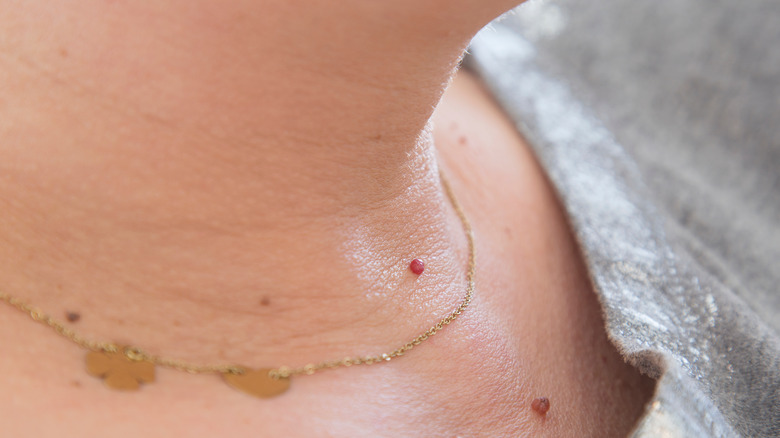Can Skin Tags Come Back After Treatment?
Containing collagen fibers, fat, and even blood vessels and nerve cells, skin tags are tiny growths that emerge on the topmost layer of our skin connected by a stalk (via Harvard Health Publishing). Most often seen on areas of the body such as the armpits, neck, underneath the breasts, eyelids, and other places particularly prone to rubbing, these flesh-toned growths are considered non-cancerous, yet can be an aesthetic concern for patients.
"They don't discriminate — they affect people of all ages and body types and can occur anywhere, including the face," dermatologist Dr. Pamela Ng tells the Cleveland Clinic. For those who wish to have a skin tag removed, there are various different treatment options from which to choose. For instance, many doctors utilize cryotherapy to freeze off the growth. Conversely, some physicians may use heat to burn off the growth in a treatment procedure known as electrocautery, which involves using an electric needle or probe. For more sizable skin tags, surgical removal with a scalpel or scissors may be advised.
Following treatment for a skin tag, how long can we expect the results to last for? In other words, can a skin tag return once it's been removed?
Once removed, a skin tag is generally gone for good
After removal, you may notice the development of a scab in place of where the skin tag once stood (via Cleveland Clinic). The scab will eventually heal and you may see some lingering marks on the skin. Over time, however, is it possible for another skin tag to grow back in the same spot?
While a skin tag will not return once removed, it is not impossible for new ones to develop within close proximity. "They tend to congregate in similar locations — skin folds, arms and neck, in between the thighs and under the breasts. So if you have one, you'll probably get more as time goes on," board-certified dermatologist at The Ohio State University Wexner Medical Center Dr. Susan Massick told AARP.
However, maintaining healthy habits, such as eating a well-rounded diet and engaging in routine physical activity, can help reduce the chances of new skin tags developing. Additionally, try and refrain from wearing clothes or accessories that may create friction between the material and skin.
Stick to professional removal over at-home remedies
Mind you, skin tags generally do not grow back after having been removed, but this is only in reference to professional removal procedures. At-home treatment methods — which include ligation bands, freezing kits, as well as the application of apple cider vinegar or tea tree oil — are generally advised against, as these can come with risks and may prompt skin irritation (via Harvard Health Publishing). All in all, there is no sufficient evidence to suggest these at-home treatment methods are effective in removing skin tags.
Even worse, some home remedies — such as cutting off a skin tag on your own — come with potentially bigger risks. You may end up damaging the skin around the site, as well as increase your chances of infection, scarring, or severe bleeding (via Cleveland Clinic). Furthermore, in the event that you're unable to remove the whole skin tag yourself, you are more likely to see it reappear.



